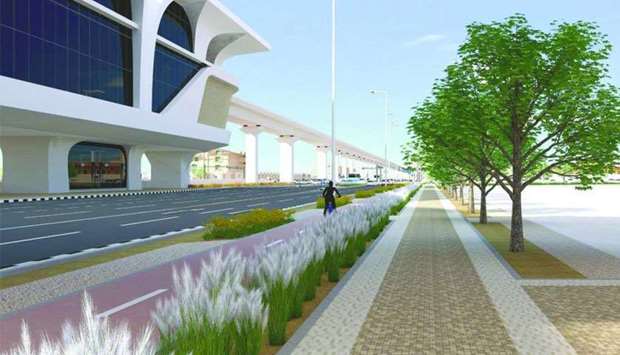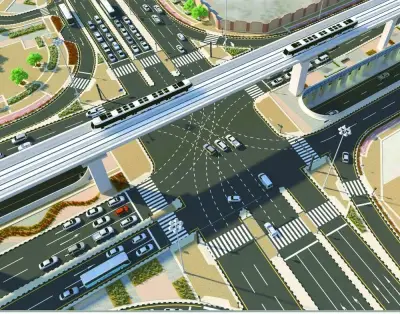As part of Al Wakrah Main Road project, Ashghal has announced that traffic to Doha from Al Meshaf and Al Wukair areas, will be diverted from Saturday until the first quarter of 2020.
For traffic from Al Wukair and Al Meshaf areas, road users can take a left turn at the signalised intersection of Saud Bin Abdelrahman Street and Al Wakra Parallel road towards Doha and Hamad International Airport.
Traffic from adjacent areas for Fahes Al Wakra & Woqod petrol station facilities can lead to reach Doha & Hamad International Airport via turning right at the junction near Woqod petrol station and making a U-turn at Al Sadafa Roundabout.
Al Wakrah Main Road is scheduled to be completed in the second quarter of 2020.The construction will take place in three stages.
The first stage starts from Barwa village, located at the Airport Interchange in the north to Al Wakrah Road and Ras Bufentas station.
The construction extends over 1.8km on a three-lane stretch in both directions of Al Wakrah Main Road. The first stage also includes 840m of subways north of the road.
The project’s second stage will extend from former Al Wakrah Roundabout up until Pearl Roundabout, with road works for approximately 1.9km. The project also includes three lanes in each direction, and a 160m tunnel located under the main Al Wakrah Qatar Rail Station.
The project’s final stage starts about 1km from the former Pearl Roundabout and extends up to Woqod Petrol Station located towards the city of Mesaieed. The construction includes the development of the 5.5km road from Al Wakrah Main Road and converting three main roundabouts, namely Pearl Roundabout, Ooredoo Roundabout and Wadi Afja Roundabout in Al Jabal area to signal-controlled intersections in addition to the construction of a junction in Al Razi Street.
Al Wakrah Main Road serves a large number of neighbourhoods, residential and commercial complexes in Al Wakrah, Al Wukair, Barwa City and Al Wakrah Market. One of the key projects in the southern area, it will ease movement of Al Wakrah residents directly towards Doha in the north and to Mesaieed in the south.
Al Wakrah Main Road Upgrade is part of the expressway networks in Qatar, as it will make a positive impact on the traffic flow in the southern area. The project will also contribute to reducing pressure on existing roads in other areas of Al Wakrah; thus, complementing the other accesses of the expressway networks, of which several parts have been recently opened such as the G-Ring Road and the southern part of Doha Express Highway “Al Wakrah Bypass”, which is connected to Al Wakrah Stadium, one of the stadiums hosting the FIFA 2022 World Cup.
Al Wukair Road: Ashghal has reconstructed Al Wukair Road that links the Orbital Road with Hamad Port Road towards Al Wukair area for a distance of 10.5km. Ashghal turned the dual one-lane road into a highway with four lanes in each direction to cater for 8,000 vehicles per hour.
Southern Doha Expressway: The 11km highway connects G-Ring Road with Mesaieed Road. It will ease access to Al Wakrah, Al Wukair and Al Mashaf areas, and it is considered an alternative route for Al Wakrah Main Road through its connection with Mesaieed Road and G-Ring Road.
Doha Expressway includes five multi-level interchanges that will be completed in the next few months. The project also comprises 42km of pedestrian and cycle paths.
Hamad Port Road: A 14km road that connects Hamad Port and G-Ring Road, and includes four lanes in each direction, easing the movement of trucks between Hamad Port and Industrial Area, enhancing the movement of goods between the port and all areas of the country, especially since the road is considered a corridor to reduce journey time.
Hamad Port Road is expected to reduce travel time by more than 15% especially that the road capacity is 8,000 vehicles per hour in each direction.
Ashghal has opened a major part of the 195km Orbital Road. It will serve as a vital link between the southern and northern areas in the country. The project also includes the construction of 21 main interchanges, including tunnels and flyovers that connect the Orbital Highway with the highways and main roads such as the G-Ring Road, Salwa Road, Dukhan Highway, and Al Shamal Road. This will significantly enhance the flow of traffic and shorten the journey times through the Orbital Highway by around 50% on average, compared to the time spent in the same journey using the existing roads.
The G-Ring Road is one of the key axis of Qatar's expressway networks. Being a highway road that provides an uninterrupted traffic flow, it had a significant positive impact on the traffic movement in the country’s southern areas. It also contributed to reducing pressure on existing roads in other areas, thus complementing the other axes of the expressway networks of which several parts will be opened to traffic throughout the coming months.
The G-Ring Road extends over 22km from Hamad International Airport to the Orbital Highway, and includes five lanes in each direction and 48km of pedestrians and cyclists lanes, surrounded by landscaping.



